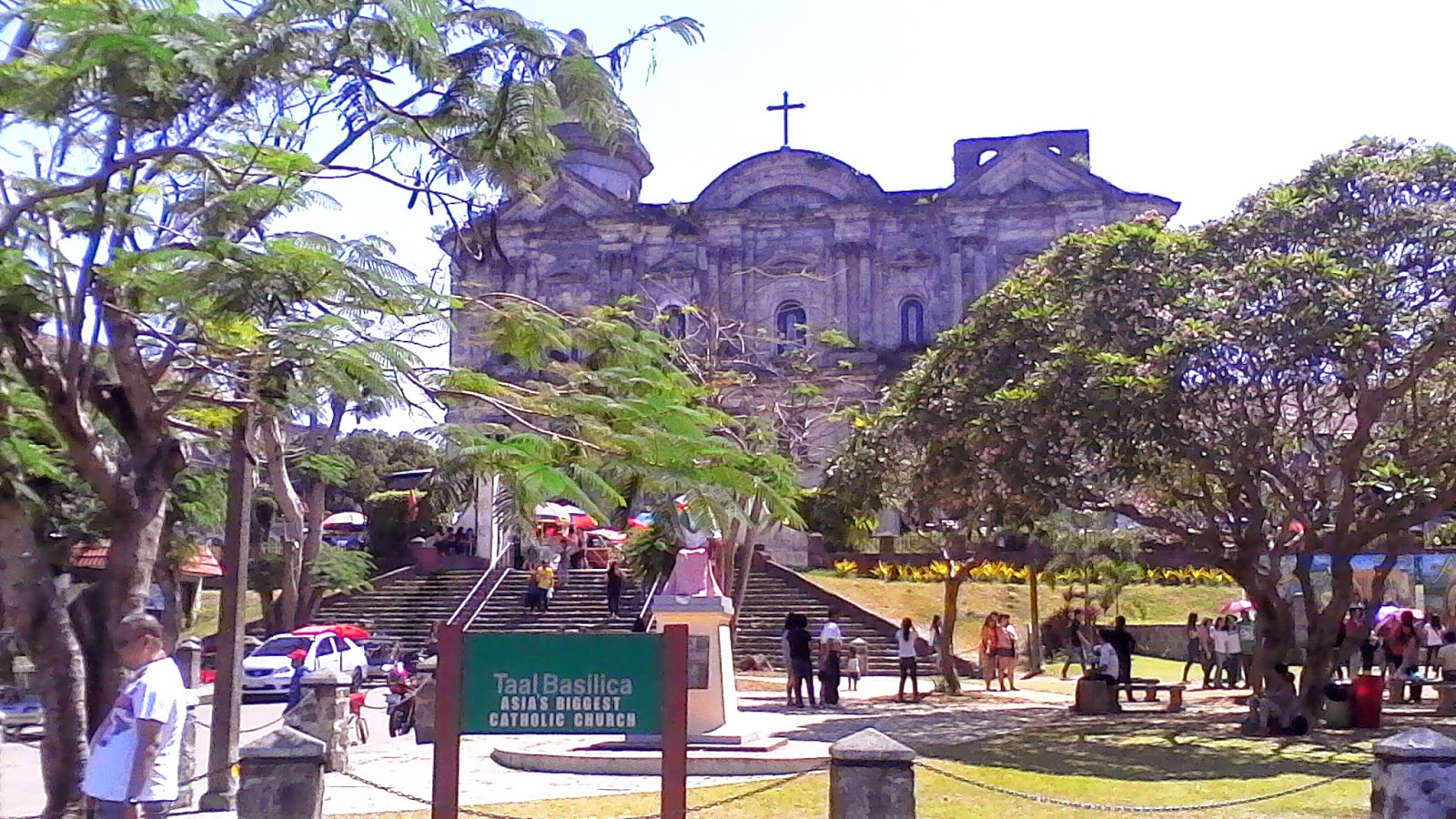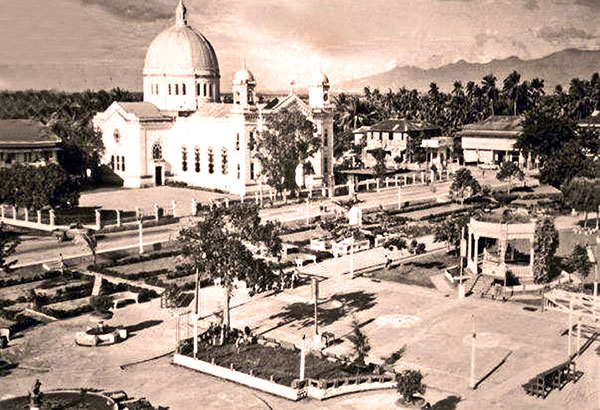Taal Basilica (St. Martin de Tours) : A Must Visit Church During Lenten Season
Photo of the Basilica from afar
Choosing the best place to visit during the holy week is very crucial. There are a lot of things to consider before finalizing your decision. As i am now living in Carmona, Cavite i decided to spend my holy week in Batangas, which i guess is more easier and comfortable to travel to. Here is some of my reason why:

- Batangas is only a few kilometers away from Cavite.
- I wanna experience and see the very popular Taal basilica.
- the bus station bound to Batangas is very near in the place i lived in.
- Bus terminal is not as crowded like in Cubao.
- I wanna explore the church and to know a little bit of its history.
The Church Facade
On the left: One of the wall design. Right: The wide and long aisle.
Brief Histor of Taal Basilica
 During Spanish time, Augustinian missionaries headed by Father Diego Espinar founded the original town of Taal near the Taal Lake which is now the municipality of San Nicolas on 1572. With his effort and dedication Fr. Diego led the town's very first church in 1575. The first erected church didn't last long until 1754. It was devastated when Taal Volcano erupted and swiped away not only the church but also the whole town. It was 1755 the church was rebuild by Augustinian missionaries with stronger materials. This time they moved it a little bit far from Taal Volcano. It was constructed on the top of a hill which is now the present location of St. martin de Tours. Father Martin Aguirre donated the land where the church located. Father Gariel Rodriguez continued the construction on 1777 and Fr. Jose Vitoria on !782. Fr. Ramon del Marco designed the church, paved the processional road with bricks around the atrium of the parochial building. He also built the convent. But for the second time it was damaged by an earthquake in year 1849.
During Spanish time, Augustinian missionaries headed by Father Diego Espinar founded the original town of Taal near the Taal Lake which is now the municipality of San Nicolas on 1572. With his effort and dedication Fr. Diego led the town's very first church in 1575. The first erected church didn't last long until 1754. It was devastated when Taal Volcano erupted and swiped away not only the church but also the whole town. It was 1755 the church was rebuild by Augustinian missionaries with stronger materials. This time they moved it a little bit far from Taal Volcano. It was constructed on the top of a hill which is now the present location of St. martin de Tours. Father Martin Aguirre donated the land where the church located. Father Gariel Rodriguez continued the construction on 1777 and Fr. Jose Vitoria on !782. Fr. Ramon del Marco designed the church, paved the processional road with bricks around the atrium of the parochial building. He also built the convent. But for the second time it was damaged by an earthquake in year 1849.When the time of parish priest Fr. Marcus Anton the church was rebuild again from 1856 to 1865. Fr. Anton summoned the famed Spanish architect Luciano Oliver to supervised the construction and design of the new church. Almost a decade later it was inaugurated even in its unfinished state. the completion of the basilica in 1878 were under the supervision of Fr. Agapito Aparicio. he added the church gigantic 79 ft. Doric style altar which makes the basilica more astounding and one of a kind.
St. Martin de Tours was declared as basilica on December 8, 1954 and became one of the country's National Shrine on January 16, 1974 by Presidential Decree No. 375.
Facade and Interior
This extraordinary edifice stands 96 meters tall, 96 meters long and 45 meters wide. Covering almost half hectare of the land area. Taal Basilica is dubbed as one of the oldest and biggest Catholic Church in Philippines and in Asia. This colossal baroque structure was made of coral stone and adobe stone slabs without any use of cement during construction. As i can see the edifice remains compact and massive until this time.
The facade of the church with 24 classical columns in pairs and lined up two rows of six on top of the others resembles that of St. Peter's Basilica in Rome. It has 10 windows and five doors. The interior is designed like a Latin cross with wide aisle on the both sides which makes the church airy and spacious. Walls were being painted with different patterns that gives you a three dimensional effect. On the left side of the facade it has its bell tower which is a good spot to see the Balayan Bay, Taal lake and the ancestral houses around. The bell tower was destroyed during Japanese occupation and was rebuilt but it was much taller than the old one.
The original ceiling were painted by Giovanni Dibela, one of two Italian artist who painted the ceiling of San Agustin Church. Dibela painted the ceiling which gave a "trompel oeil" or trick of the eye effect.
Restoration
In preparation for the Canonical Coronation of Our Lady of Caysasay the church was restored on 1953. The was again restored in 1972 by the Taal Quadricentennial Council for the 400th anniversary of the town's establishment. In 1990 the damage belfry was restored under the supervision of the National Historical Institute. St. Martin de Tours underwent a massive restoration in 2011 under the assignment of Msgr. Alfredo Madlangbayan. church interiors was restored to its original trompel oeil ceilings. Also the tower was restored originally with its new set of carillon bells. November of the same year when the restoration completed.
Distinct Features
Above: The Bell Below: The main altar with the Silver Tabernacle.
One of the distinct features of the church was its Silver tabernacle claiming to be one its kind. Another is the bell which is considered to be the biggest in the country. This massive instrument is 19 feet (5.8m) in circumference at the lip. 9.33 feet (2.84m) around the crown and 6.42 feet (1.92m) in height.
How to get there:
The heritage town of Taal is very recognizable. With the church structure and it is elevated it can be easily seen. The Taal Basilica of St. Matin is just around the Taal Park. For complete directions you can check it HERE.
_0_
This magnificent church is a living history that attest time. Its history will last forever. It will never fade and continue to lived in our hearts. Its structure is as big as our love to God almighty. This symbolizes us that no matter what happen through thick and thin or how many times we stumble God will always help us recover and help us stand. With God's grace nothing is impossible. What is your holy week experience share it below!
References:















Comments
Post a Comment